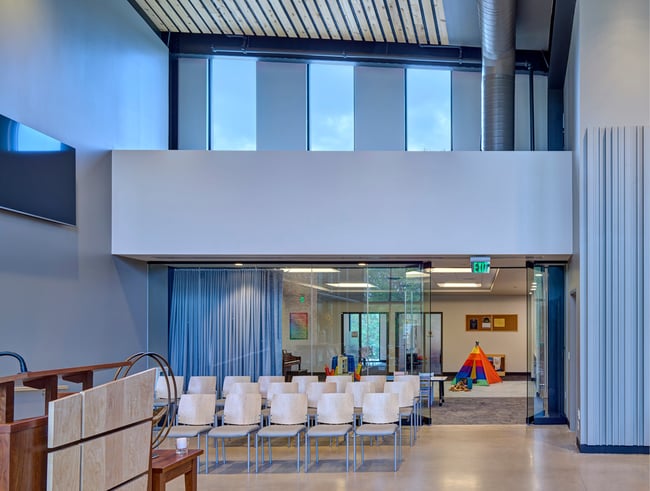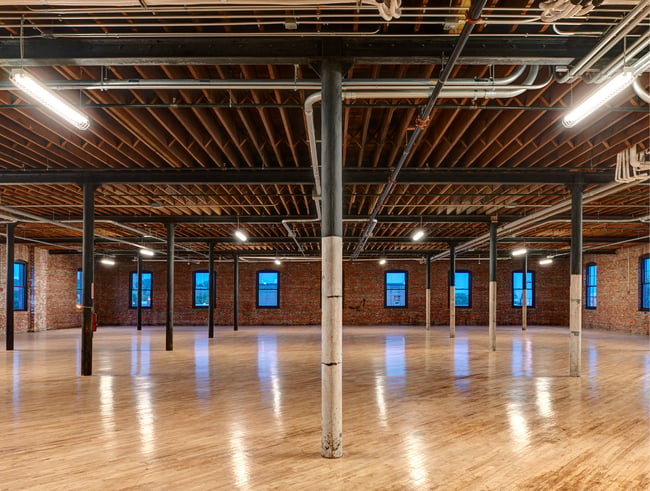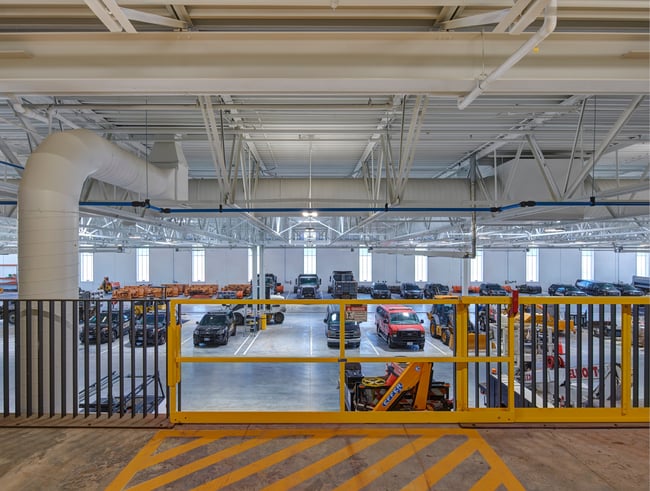Improving Energy Performance on 3 Building Types

Energy performance is one of the most important aspects of a building project. Heating and cooling costs are some of the largest expenses of building ownership, so the decisions you make during the design process can have a long-term impact on your bottom line.
While there are some general rules to follow for improving building performance, every project is different. Strategies that work for an office building may not be as effective in a manufacturing facility.
Real-world examples can help demonstrate the best practices for improving performance. This article will discuss strategies used on three Neumann Monson projects: Unitarian Universalist, Market One, and Iowa City Public Works (ICPW).
Each facility represents a different building type. Unitarian Universalist is a worship facility with fluctuating occupancy numbers throughout the week, and Market One is a commercial adaptive reuse project. ICPW, on the other hand, is a municipal building used for vehicle storage and maintenance.
Worship: Unitarian Universalist
When the Unitarian Universalist Society decided to build a new home in Coralville, they challenged themselves to become “the greenest church in Iowa.” To accomplish this goal, they explored many building rating systems and decided to pursue a Zero Energy Certification through the International Living Future Institute.
The Zero Energy program recognizes buildings that produce 100% of their energy needs on-site through renewable, non-combustible resources.
Reaching this goal began by creating a super-insulated envelope to minimize energy losses. Glazing, larger in communal areas and smaller in more intimate spaces, helps the exposed radiant concrete floor modulate the temperature. Clearstory windows on the building’s opposite end extend the hours of daylighting effectiveness, reducing the need for artificial LED lighting.
The client also chose a ground-source geothermal heat pump for the mechanical system. The system uses the earth’s relatively stable temperature for heating and cooling the building throughout the year.
All systems and appliances are electric and powered by an on-site solar array—financed through a Power Purchase Agreement. Together, these strategies led to a facility that produced 110% of its energy needs in its first year of operation.

Clearstory windows to maximize daylighting effectiveness.
Commercial Adaptive Reuse: Market One
Market One is an adaptive reuse project that transforms a turn-of-the-century farm equipment factory into a contemporary office building. At the beginning of the design process, the client set their sights on achieving LEED Platinum—the highest of LEED’s four rankings. They also aimed to receive federal historic tax credits.
To receive tax credits, the project team had to follow strict guidelines and maintain the building’s historic features—challenging traditional energy efficiency strategies. Increasing insulation and improving glazing were not possible under the historic tax credit requirements, and the team needed to find other ways to decrease and offset energy demand.
One strategy was using a ground-source Variable Refrigerant Flow (VRF) to heat and cool the building. VRF systems transport heating and cooling through pipes and use less ductwork than traditional Variable Air Volume (VAV) systems, making them more efficient.
At Market One, the system allowed the design team to maintain the building’s original volumes. Pipes to not require drop ceilings or additional coverings, minimizing visual clutter and inconsistencies with the historic nature of the building.
To further offset electrical consumption, the client added a photovoltaic array on the roof and over the adjacent surface parking lot. Inside, occupancy sensors monitor LED lighting and fixture operation to maintain the building’s energy use.

VRF system helps maintain the building's historic volumes.
Municipal Building: Iowa City Public Works (ICPW)
ICPW houses the city’s streets and water divisions and their associated vehicles and equipment. The city had set the ambitious goal of achieving net-zero carbon emissions by 2050 and made sustainability a top priority during the design process.
With its multiple functions, the building required unique strategies for maintaining energy efficiency. The design team started with volumetric studies to find the most efficient building form.
They also added extra roof and wall insulation and sized openings to provide daylight while minimizing the burden on the mechanical system. Daylighting reduces the need for electrical lighting while improving worker safety and well-being.
Separate mechanical zones optimize efficiency in different contexts. Vehicle storage maintains a temperature of 50 degrees, which is warm enough to keep hydraulics operational in the winter and reduce idle times. Shop and office spaces are in separate zones to maintain occupant comfort.
Additionally, the facility’s roof was designed to support solar panels. If completely covered in photovoltaics, the facility can produce more energy than it uses. Solar panel installation began in 2022.

Vehicle storage bays are zoned separately from other spaces.
Learn More About Sustainable Design
Although Unitarian Universalist, Market One, and ICPW are all highly efficient, they required different approaches.
While daylighting strategies and additional insulation helped Unitarian Universalist achieve net positive energy, Market One’s historic features prevented the use of these strategies. Instead, the design team needed to prioritize the mechanical system and offset electrical consumption through solar panels.
ICPW required a different perspective. The building’s multiple uses increased the risk of mechanical inefficiencies, so the design team prioritized insulation and created separate thermal zones for different functions.
Energy efficiency is only one aspect of sustainable design. It’s equally important to consider the local ecosystem and the needs of the broader community. Learn more by reading how Unitarian Universalist, Market One, and ICPW incorporated strategies that manage storm water and prevent flooding.